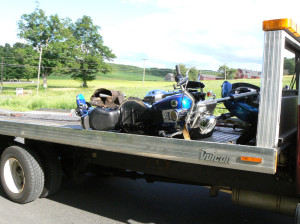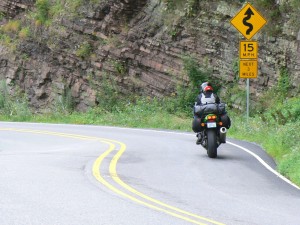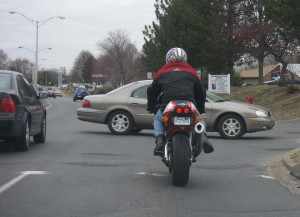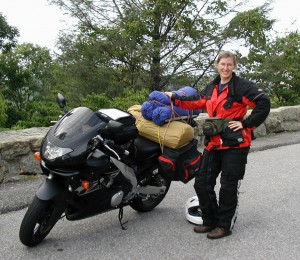
I thought it might be fun to share a sampling of statements I hear often from Mr. and Mrs. Non-riding Public, along with my usual response. Perhaps these statements are familiar to you, too. And maybe your responses are similar to mine. Whatever.
#1: “Aren’t You Hot?”
This is directed toward the fact that I’m wearing a jacket, riding pants, gloves, etc. This question often makes me scratch my head, because I assume that people understand the concept of wind chill factor and can imagine that the gear I have on is perfect, not only for comfort, but also for protection.
Yeah, they don’t seem to understand that riding gear is a compromise. Even the best vented gear can be hot even at speed, but I won’t ride without protection. Grasping that concept seems a bit too difficult for Mr. and Ms. Public without some patient education.
My response: “Not once I’m rolling over 30mph.” “Besides, I need the protection, just in case”.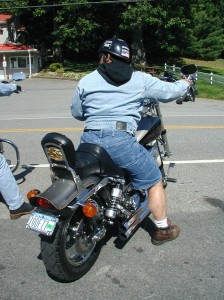
#2: “I Don’t Like Motorcycles…They’re too Loud”
This usually comes up in conversation at parties when I disclose that I am a motorcycle rider. I can fully understand the non-motorcyclists’ reaction to obnoxiously loud pipes. Even as a career rider, I am annoyed and barely tolerant of loud motorcycles. Imagine the lack of tolerance Mr. and Ms. Public has for riders who invade their peace and quiet.
My response: “I don’t like loud motorcycles either.” “Do you know that motorcycles aren’t loud when they are ridden out of the showroom?”
Stunned silence usually follows as they try to comprehend that someone would take a perfectly good (quiet) motorcycle and make it obnoxious…on purpose.
I get it. A motorcycle that makes no sound seems to lack a visceral depth that most riders value. But, personally, I’ve come to value not invading others’ auditory space with my exhaust, so I keep my street bike exhausts stock.
I recently rode an electric “Zero” motorcycle and I can tell you that the total lack of engine sound did not take away from the awesome performance and unique experience of this torquey, fun machine. I contend that excessive noise detracts from riding enjoyment, rather than enhances it.
And then there is the “Loud Pipes Save Lives” theory. While I understand that loud pipes can get attention, making a bunch of racket is NOT a reliable way to get people to avoid you. Lane position and other strategies that allow you to be SEEN are much more effective ways to avoid a mishap.
Besides, sound is directional, so exhausts pointed rearward are of little benefit when the most likely collision scenario involves an approaching vehicle turning left across your lane at an intersection.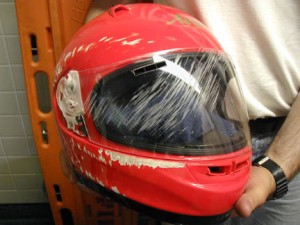
#3: “Aren’t Motorcycles Dangerous?”
This question needs no explanation, except that people who ask are implying that because it is risky to ride a motorcycle, that I must be a person who exercises poor judgment. These are often people who value safety and therefore distance themselves from risk…at least things they deem risky, which is most likely things they don’t understand.
Not everyone who asks this question is afraid of risk. Sometimes they are just responding to a preconceived notion of how dangerous motorcycles are. This deduction comes from horror stories heard from acquaintances and from sensational news reports. We all have prejudices based on indirect knowledge and assumptions. These people are simply reacting to what they think is the truth.
Unfortunately, it is true that riding a motorcycle is dangerous. So, how do I respond?
My response: “Yes, riding a motorcycle isn’t for everybody. If you’re not a person who is committed to being as skillful and conscientious as possible, then you probably don’t belong on a bike.”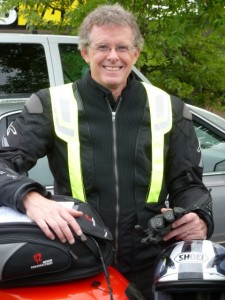
#4: “Where are Your Tattoos?”
Really? Yep. This silly question usually comes from the mouths of people who make assumptions about what motorcycle riders “look like” and probably don’t personally know a motorcycle rider, or don’t know a motorcycle rider who does not have tattoos.
The “biker types” get the attention of the general public because they make a lot of noise and go out of their way to look tough with their ink and leather “costumes”. These bikers get Mr and Ms. Public’s attention so that their perception is that motorcycle riders dress the way the loud riders dress.
I challenge the ignorance of stereotypes by looking “normal”. Sure, I have my own costume, but it is that of a rider who embraces a motorcycling lifestyle as a sport, daily transportation, and a way to see faraway places.
My response: “Shut the Hell Up.” Just Kidding. I might joke about having ink in places I can’t show in public and say it in a way that makes them question their assumptions of what some riders look like. And then I walk away.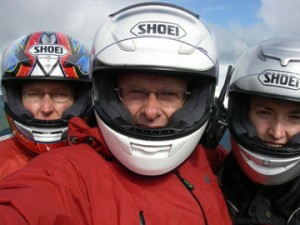
#5: “How Do You Get Three People on one Motorcycle or do you have a sidecar?”
This question was directed toward my wife when she, our then 10 year old daughter, and I walked into a restaurant on a family motorcycle trip several years ago with all of our riding gear in hand. Caroline hesitated for a moment in disbelief as she finally realized that the person assumed that women do not ride their own motorcycles, therefore the only explanation must be that we all somehow fit on one motorcycle or that a sidecar was the answer. A woman on her own bike never crossed their mind.
Her response: “I ride my own motorcycle, and have been for over ten years.”
Please Donate to Keep the Articles Coming
If you liked this article and the many other articles on this site, please toss a buck or five into the hat. It’s greatly appreciated!
- Click the PayPal “Pay Now” button.
- Then indicate quantity in $2.00 increments. – Example: put “2” in “QUANTITY” field to donate $4.00, “3” for a $6.00 donation, etc.
Why $2.00? Due to the PayPal fee structure, a $2.00 donation is significantly more beneficial compared to a $1.00 donation.
Thank You!
Stay Informed: Subscribe NOW!
Be a Better Rider: Sign Up for Personal Training with Ken
Support Riding in the Zone: Buy a book
Support Riding in the Zone: Buy products from Twisted Throttle & Amazon
Add your examples, below.
Check out these related posts:

